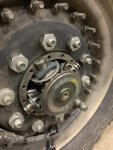picture is worth a thousand words, you are simply ripping all this garbage out and connecting the inner axle to the outer hub.
View attachment 899625
Thanks. The names of th
Does anyone with the ECO hub conversion have an EGT gauge in their truck? If so, what were the EGT differences before and after the hub conversion? I ask because I have limited diesel experience with small Japanese RHD vans. In their case, running mid RPM range would create very high EGTs, where as low RPM and High RPM would keep them in check. There has been lots of discussion about these hubs keeping the engine in the sweet spot as far as torque is concerned, that tells me best use of turbo, also tells me potentially higher EGTs with sustained mid RPM traveling. Just a point of curiosity for me. Thanks in advance for any insight on this side topic.
Scott
I drove an old dump truck with that issue.
If you want to know where your "sweet spot is" see if the marine folxs use your engine.
Eg. The 3116 is very highly used in marine applications. And they have detailed conversations about RPM and Propeller tuning for cruise vs. WOT etc etc.
In the case of the 3116, sustained cruise operation above 2400 rpm is said to reduce engine longevity, 2850 rpm is said to be a reasonable Rev limiter.
The military tried to dumb things down so they chopped 250 RPM off your top end and the military 3116 usually hits Rev somewhere around 2600, maybe a bit lower.
Stock the army set these things up to cruise indefinitely at between 45 and 50 mph, and then you use the extra few MPH to wind up the turbo right before you hit a hill.
Your power band kicks in pretty low, so really, if your automatic transmission has picked an RPM for you, it's in the acceptable long or medium long engine longevity range.
Depending on the engine and the truck you probably don't have to worry about the pyrometer. For my MUI 3116, in an m1078 LMTV the military took about 60 HP or more off the engine's actual top performance by HP/torque--again, they're giving these to 19 year olds, so they aren't trying to make them easily abusable.
Eg. You aren't even capable of true MID RPM range WOT operation.


